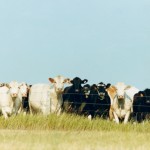Some Idaho Farmers Suffer, Others Succeed In Summer’s Drought

Molly Messick / StateImpact Idaho
Farmer Hans Hayden says this spring wheat field is an almost total loss.
In Idaho’s arid, high desert, the drought has a mixed effect. There’s a big divide between farmers with deep wells and irrigation, and those without.
Hans Hayden is a rare find: a talkative farmer. He likes to explain things. But when it comes to the wheat he planted this spring, there’s not much to say. This field needed rain it didn’t get.
“At this point in time, it kind of looks like a desert,” Hayden says.
In a good year, his spring wheat would be nearly three feet high by now. The top of each stalk – the head – would be heavy with grain.
Hayden walks across his field’s gentle slope. He steps on stunted rows and kicks up dust. He stops, and picks a single stalk of wheat.
“You start seeing here? These heads have very few kernels in them if they even are here,” he says.
He rolls the head in his hand, literally separating wheat from chaff. But he doesn’t find a single seed. “See, there’s none in that one, and there should have been 26 to 45 in that head.”
Hayden has 1,400 acres of drought-withered wheat. He’s calling it an almost total loss.
Not far from Hayden’s farm, the slender arm of a pivot irrigation system arches over a cornfield. It sends out 3,000 gallons of water per minute. This is Jim Tiede’s farm, and he can barely hold back a grin.
“This is the time of year when you finally have the payday, and all of the work you do for the whole year, and planning, and the budgets and – now this is the fun time of year when you get to reap what you’ve sown!” he says.
Across the road, Tiede’s potato plants are getting the same steady spray of water. His wheat fields are a short drive away. The kernels are plump. The field stirs and sways in the breeze.
“You can hear the wheat rattling as we walk through,” Tiede observes.
A crop like this isn’t luck. After the wheat came up in spring, it was irrigated for 60 days straight.

Molly Messick / StateImpact Idaho
Tiede expects his wheat crop will bring in a good profit in this year when wheat is selling for more than $8 a bushel.
Stan Gortsema is retired now, but he spent 34 years as the county extension agent.
“There’s no such thing as drought under a pivot irrigation system,” he says. “I mean, turn the water on!”
Gortsema says this divide – between the so-called dry-land farmers, who don’t have irrigation, and the irrigated farmers, who do – is especially big in this area. A dry-land farmer plants, and prays.
“He’s looking to the heavens, saying ‘Come on, big guy! Give me some rain!’ And if it happens, it happens. And if it doesn’t, he can lose his whole crop!”
The irrigated farmer is in a completely different business. Wheat is an Idaho dry-land farmer’s livelihood. For irrigated farmers like Tiede, potatoes and sugar beets are the cash crops. The wheat is there to give the fields a rest. Most years, Tiede breaks even growing it. He says that’s because irrigated farming has a hefty price tag.
“I’ll just give you a rough example, my operating loan for 3,000 acres is about $2.3 million,” Tiede says.
Every year, Tiede takes out a $2.3 million loan just to cover the upfront costs of getting his crops in the ground. Costs like his $100,000 monthly power bill. It takes a lot of electricity to pump water in a desert.
These big differences between Hans Hayden and Jim Tiede’s operations are mostly a matter of historical accident. Both men farm land settled by their grandfathers. A century ago, all southeast Idaho farming was dry land. Then well-drilling technology came along, and the Tiedes struck gold. Their farm sits over an aquifer. Hayden’s doesn’t. But he’s okay with that.
“I really like raising wheat,” he says. It’s a simple sentiment. But for him, it’s enough.
“The bigger the irrigated farmer, the more he becomes a personnel manager. He never drives his own tractor,” Hayden explains. “Sometimes if you get very big, you just manage the managers. So then you’re sitting in an office, and you changed your position.”
This year, Hayden will lose money, while irrigated farmers nearby have a chance at record profits. But Hayden will stick with the life he has.


